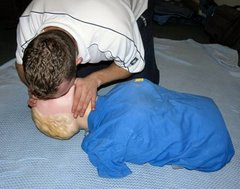Diabetes Mellitus
In Diabetes Mellitus (DM) the body fails to produce sufficient amounts of insulin, the hormone that converts blood sugar to stored glycogen. Diabetes Mellitus comes in two varieties - insulin dependent (IDDM) and non-insulin dependent (NIDDM). Traditionally these were also know as Juvenile Onset and Mature Onset respectively, but because of downward trends in diet and lifestyle NIDDM can now occur at a much younger age. Those with IDDM have to have regular injections of insulin, whereas those with NIDDM are treated by oral medication and dietary control.
In DM the blood sugar (BS), which has a normal value around 4 - 6 mmol/litre, is either raised due to too much sugar/not enough insulin (hypergycaemia) or lowered due to not enough sugar/too much insulin (hypoglycaemia).
If a known diabetic casualty appears unwell and you are unsure if they are hyper- or hypoglycaemic give them sugar - this will rapidly correct hypoglycaemia and will do little harm in the case of hyperglycaemia.
Hyperglycaemia (BS too high):
Recognition:
Recognition:
In DM the blood sugar (BS), which has a normal value around 4 - 6 mmol/litre, is either raised due to too much sugar/not enough insulin (hypergycaemia) or lowered due to not enough sugar/too much insulin (hypoglycaemia).
If a known diabetic casualty appears unwell and you are unsure if they are hyper- or hypoglycaemic give them sugar - this will rapidly correct hypoglycaemia and will do little harm in the case of hyperglycaemia.
Hyperglycaemia (BS too high):
Recognition:
- Recent history of eating excessively.
- Casualty is thirsty but not hungry, may vomit and may urinate excessively.
- Breathing is rapid.
- Breath smells fruity/sweet
- Pulse rapid and weak.
- Skin warm and dry.
- Casualty does not usually have a seizure.
- Casualty appears drowsy.
- Symptoms usually develop gradually.
- Arrange urgent medical treatment for the casualty.
- Dial for an ambulance immediately.
- Monitor the casualty's breathing, pulse and level of responsiveness.
- Be prepared to resuscitate if the casualty stops breathing.
Recognition:
- History of under eating, missed or irregular meals.
- Casualty is thirsty but not hungry, doesn't (usually) vomit and urinates normally.
- Casualty is disoriented and acts unusually.
- Breath smells normal.
- Pulse rapid and strong.
- Skin pale, cold and clammy.
- Casualty may have a seizure.
- Casualty rapidly loses consciousness.
- To raise the casualty's BS.
- To get medical help if necessary.
- Help the casualty to sit or lie comfortably. Give him/her a sugary drink, sugar lumps or anything else sweet. Alternatively, some diabetics carry a glucose gel for use in a 'hypo' - help them to use this.
- If the casualty responds quickly give more food and advise the casualty to rest until they feel better. Advice him/her to see their own doctor even if they feel fully recovered.
- If they do not respond look for alternative causes.
- Monitor the casualty's airway, breathing and responsiveness.
- If the casualty is unconscious place them in the recovery position and dial for an ambulance.
- Be prepared to resuscitate if the casualty stops breathing.



